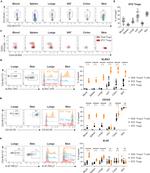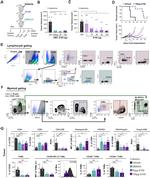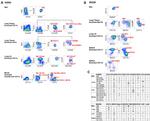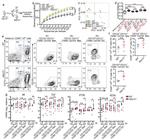Search Thermo Fisher Scientific
Invitrogen
CD103 (Integrin alpha E) Monoclonal Antibody (2E7), PE-eFluor™ 610, eBioscience™
FIGURE: 1 / 5
CD103 (Integrin alpha E) Antibody (61-1031-82) in Flow





Product Details
61-1031-82
Species Reactivity
Published species
Host/Isotype
Recommended Isotype Control
Class
Type
Clone
Conjugate
Excitation/Emission Max
Form
Concentration
Purification
Storage buffer
Contains
Storage conditions
Shipping conditions
RRID
Product Specific Information
Description: The 2E7 monoclonal antibody reacts with mouse CD103, the alphaE integrin. CD103 non-covalently associates with integrin beta7 and is expressed on all intraepithelial lymphocytes, a small subset of peripheral lymphocytes, and dendritic epidermal T cells (DEC). Epithelial cell antigen E-cadherin binds to CD103 and mediates homing of lymphocytes to the intestinal epithelium.
Applications Reported: This 2E7 antibody has been reported for use in flow cytometric analysis.
Applications Tested: This 2E7 antibody has been tested by flow cytometric analysis of mouse lymph node cells. This may be used at less than or equal to 0.5 µg per test. A test is defined as the amount (µg) of antibody that will stain a cell sample in a final volume of 100 µL. Cell number should be determined empirically but can range from 10^5 to 10^8 cells/test. It is recommended that the antibody be carefully titrated for optimal performance in the assay of interest.
PE-eFluor 610 can be excited with laser lines from 488-561 nm and emits at 607 nm. We recommend using a 610/20 band pass filter (equivalent to PE-Texas Red). Please make sure that your instrument is capable of detecting this fluorochrome.
Light sensitivity: This tandem dye is sensitive to photo-induced oxidation. Please protect this vial and stained samples from light.
Fixation: Samples can be stored in IC Fixation Buffer (Product # 00-8222-49) (100 µL of cell sample + 100 µL of IC Fixation Buffer) or 1-step Fix/Lyse Solution (Product # 00-5333-57) for up to 3 days in the dark at 4°C with minimal impact on brightness and FRET efficiency/compensation. Some generalizations regarding fluorophore performance after fixation can be made, but clone specific performance should be determined empirically.
Excitation: 488-561 nm; Emission: 607 nm; Laser: Blue Laser, Green Laser, Yellow-Green Laser.
Target Information
CD103 (ITGAE, Integrin alpha E) is molecule that is expressed on mucosa-associated T lymphocytes and activated cells and on subet of TGF beta -1 cells. In particular, CD103 includes a 150kDa alpha chain and a 120kDa beta chain. CD103 is expressed by 0.5 to 2% of resting lymphocytes in peripheral blood and lymphoid organs. CD103 antibody stains a few bone marrow cells and, rarely, peripheral blood lymphocytes. CD103 is part of the integrin family which are heterodimeric integral membrane proteins composed of an alpha chain and a beta chain. ITGAE encodes an I-domain-containing alpha integrin that undergoes post-translational cleavage in the extracellular domain, yielding disulfide-linked heavy and light chains. In combination with the beta 7 integrin, CD103 protein forms the E-cadherin binding integrin known as the human mucosal lymphocyte-1 antigen. CD103 is preferentially expressed in human intestinal intraepithelial lymphocytes (IEL), and in addition to a role in adhesion, it may serve as an accessory molecule for IEL activation. Diseases associated with CD103 dysfunction include hairy cell leukemia and splenic marginal zone lymphoma.
For Research Use Only. Not for use in diagnostic procedures. Not for resale without express authorization.
How to use the Panel Builder
Watch the video to learn how to use the Invitrogen Flow Cytometry Panel Builder to build your next flow cytometry panel in 5 easy steps.
Bioinformatics
Protein Aliases: CD103; DC; DCs; Integrin alpha M290; Integrin alpha-E; Intregrin alpha E2; MGC141996
Gene Aliases: A530055J10; alpha-E1; alpha-M290; aM290; CD103; Itgae
UniProt ID: (Mouse) Q60677
Entrez Gene ID: (Mouse) 16407

Performance Guarantee
If an Invitrogen™ antibody doesn't perform as described on our website or datasheet,we'll replace the product at no cost to you, or provide you with a credit for a future purchase.*
Learn more
We're here to help
Get expert recommendations for common problems or connect directly with an on staff expert for technical assistance related to applications, equipment and general product use.
Contact tech support

